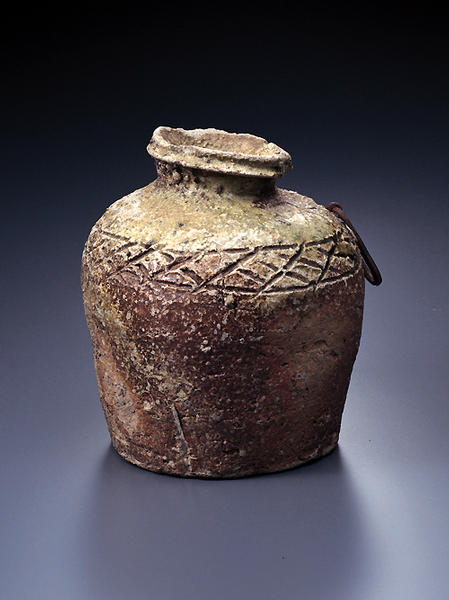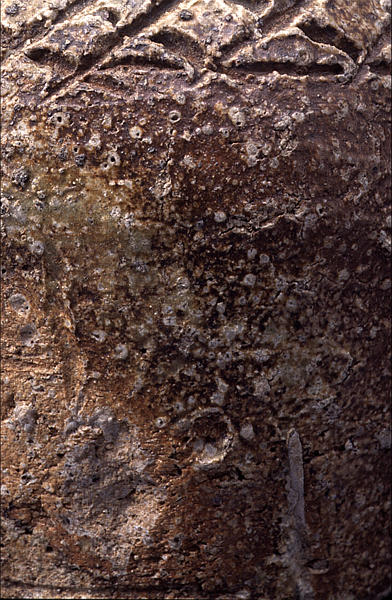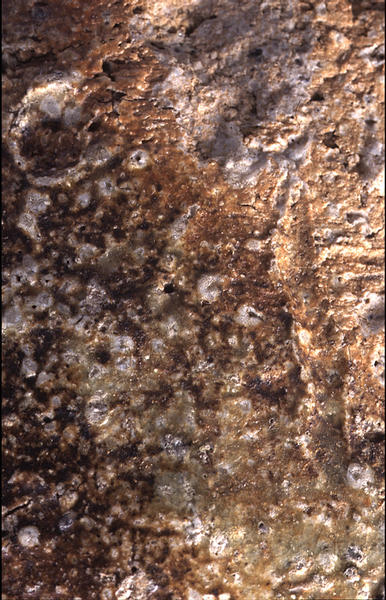信楽桧垣文蹲壺
- 滋賀県・信楽窯
- 室町時代
- 15th
- H-16.5 D-15
室町時代中期 15世紀
高:16.5cm 口径:7.0-7.5cm 胴径:14.7cm
底径:11.3-11.8cm
信楽を特色づける「蹲」と呼ばれる檜垣文小壷である。蹲特有の二重口をしたやや太い口頚部は焼き歪みによって少し傾いている。肩は張って径の大きい底部にほぼ直線を描く胴部はほとんど膨らみがない。肩に太い箆で豪放に描かれた桧垣文はこの小壷に力強
さを与えている。よく焼き締まっていて,器肌の表面は白色と茶褐色の焼きむらが見られ,口頚部から底部にかけて掛かった明るい緑色の自然釉とが見事に調和して,素朴さのなかに一種の幽玄さをたたえている。
口頚部に後からの穿口があり,掛花生として転用されたものであろう。(楢崎)
やや傾いた太い口頸部をもつ蹲である。口づくりは二重口で、肩は張って径の大きい底部にかけてほぼ直線を描く稜線をなす。肩部には檜垣文が太く豪快に刻まれている。よく焼き締まっていて、降りかかった灰が熔けて明るい緑色の自然釉となり、赤褐色の火色の器肌に白い抜けが生じて見事な景色となっている。形は小さいが、しっかりと刻まれた檜垣文が全体を力強いものにしている。肩部には「个」印が刻まれている。
蹲(うずくまる)
やや小型の壺で人がしゃがみ込んだ姿のように見えるところから名付けられています。信楽焼独特のものです。
信楽壺
桧垣文(ひがきもん)
斜めに交差した連続する文様のこと。縄目文ともいい、これも信楽焼の特徴のひとつです。
Catalogue Entry
Mid-Muromachi period, 15th century
Shigaraki ware, natural ash glaze and incised decoration
Height, 16.5cm; mouth diameter, 7.0-7.5cm;
torso diameter, 14.7cm; base diameter, 11.3-11.8cm
This is a small jar with an incised fence motif that is called an uzukumaru, or squat shape jar, a characteristic form of Shigaraki ware. The double-layered mouth common to the uzukumaru form is slightly tilted here, indicating that the mouth and neck area were warped in the firing process. The shoulder swell and the large diameter of the base means that there is a direct fall from shoulder to base, with almost no swelling at the torso. The brushwood fence motif carved loosely with a spatula across the shoulder area gives a powerful force to this small jar. Well-fired, the surface of the jar shows a mottling of white and brown colors caused by the firing, a coloration that harmonizes marvelously with the bright green natural ash glaze that flows from the mouth-neck area to the base. These elements reveal the mysterious quality amidst the jar's seemingly simple form.
The back of the neck area was pierced after its production, and this jar was probably changed into a hanging flower vase at some time in its life. SN


